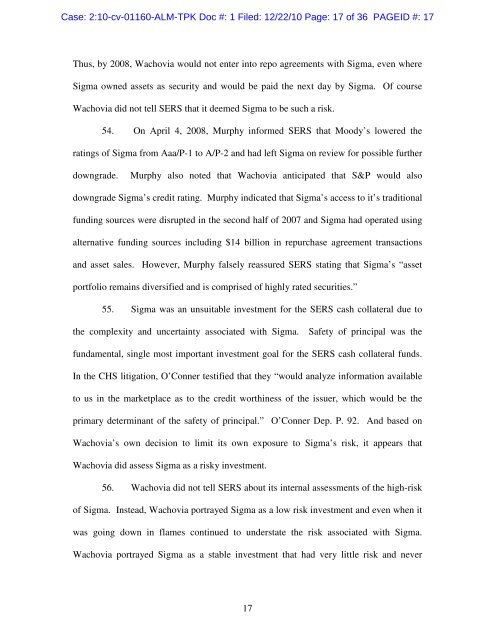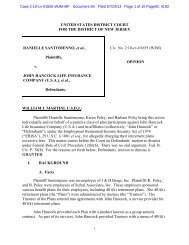Case: 2:10-cv-01160-ALM-TPK Doc #: 1 Filed: 12/22/10 Page: 1 of ...
Case: 2:10-cv-01160-ALM-TPK Doc #: 1 Filed: 12/22/10 Page: 1 of ...
Case: 2:10-cv-01160-ALM-TPK Doc #: 1 Filed: 12/22/10 Page: 1 of ...
Create successful ePaper yourself
Turn your PDF publications into a flip-book with our unique Google optimized e-Paper software.
<strong>Case</strong>: 2:<strong>10</strong>-<strong>cv</strong>-<strong>01160</strong>-<strong>ALM</strong>-<strong>TPK</strong> <strong>Doc</strong> #: 1 <strong>Filed</strong>: <strong>12</strong>/<strong>22</strong>/<strong>10</strong> <strong>Page</strong>: 17 <strong>of</strong> 36 PAGEID #: 17Thus, by 2008, Wachovia would not enter into repo agreements with Sigma, even whereSigma owned assets as security and would be paid the next day by Sigma. Of courseWachovia did not tell SERS that it deemed Sigma to be such a risk.54. On April 4, 2008, Murphy informed SERS that Moody’s lowered theratings <strong>of</strong> Sigma from Aaa/P-1 to A/P-2 and had left Sigma on review for possible furtherdowngrade.Murphy also noted that Wachovia anticipated that S&P would alsodowngrade Sigma’s credit rating. Murphy indicated that Sigma’s access to it’s traditionalfunding sources were disrupted in the second half <strong>of</strong> 2007 and Sigma had operated usingalternative funding sources including $14 billion in repurchase agreement transactionsand asset sales. However, Murphy falsely reassured SERS stating that Sigma’s “assetportfolio remains diversified and is comprised <strong>of</strong> highly rated securities.”55. Sigma was an unsuitable investment for the SERS cash collateral due tothe complexity and uncertainty associated with Sigma. Safety <strong>of</strong> principal was thefundamental, single most important investment goal for the SERS cash collateral funds.In the CHS litigation, O’Conner testified that they “would analyze information availableto us in the marketplace as to the credit worthiness <strong>of</strong> the issuer, which would be theprimary determinant <strong>of</strong> the safety <strong>of</strong> principal.” O’Conner Dep. P. 92. And based onWachovia’s own decision to limit its own exposure to Sigma’s risk, it appears thatWachovia did assess Sigma as a risky investment.56. Wachovia did not tell SERS about its internal assessments <strong>of</strong> the high-risk<strong>of</strong> Sigma. Instead, Wachovia portrayed Sigma as a low risk investment and even when itwas going down in flames continued to understate the risk associated with Sigma.Wachovia portrayed Sigma as a stable investment that had very little risk and never17







